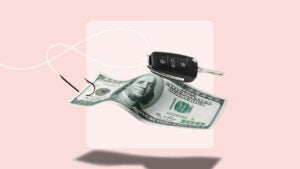How fraudsters are using fake identities to get auto loans

When conjuring an image of fraud, you likely picture someone with dark sunglasses peering over your shoulder when entering your ATM PIN. But savvy fraudsters are now combining pieces of real stolen information to create new, synthetic identities — and using those identities to walk away with new cars.
According to a recent report from TransUnion, synthetic identity fraud has reached record levels, especially in the auto financing realm. This is due to two main factors, explains Jason Lord, vice president of product marketing for fraud and identity solutions at TransUnion. First is an increase in purchasing and financing cars online, and second, the vast growth of criminal access to synthetic identities.
Auto loans make up majority of money stolen with synthetic identities
The TransUnion report explains that while most industries saw a decline in synthetic identity fraud or remained relatively stable, the auto industry was a clear exception. In just the first half of 2023, there was a 38 percent increase year-over-year. This is the second consecutive year of an upward trend, noted the release.
This increase isn’t just numbers on a spreadsheet. It has real consequences for the industry — resulting in $1.8 billion worth of fraudulent auto loans that will never be repaid. This is compared to $994 million in bank credit card access and $57 million in unsecured personal loans.
“Fraudsters continue to gravitate toward the industry that they perceive as the most profitable to them,” explains Shai Cohen, senior vice president of global fraud solutions at TransUnion.
The ease of financing and purchasing your vehicle online and the fact that a vehicle is a big ticket item make it the perfect cash-out opportunity, shares Lord.
What are synthetic identities?
“Synthetic identities are sort of like the Frankenstein of identity,” Lord describes.
The criminal takes real information about multiple real people — living or deceased — to piece together a new, convincing identity.
“It could be a child’s Social Security number, or it may be the physical address of a convicted felon who’s now in prison,” Lord says.
Then, they use this identity to apply for credit, such as auto loans, personal loans or credit cards.
The real information incorporated into the identity means it raises fewer flags in an automated loan underwriting process than a fully invented identity would. This is effective in the automotive financing industry because the software companies use to make lending decisions lacks the sophistication to spot this type of fake identity. So, while using this software allows lenders to make faster decisions, it can result in errors that manual checks would not allow for.
“They’ll check the veracity of an individual identity element, but like, say, is this address real? Yes, it is. Is the Social Security number real? Yes,” Lord explains.
So, from the lender’s perspective, this false identity is a real individual looking to finance their next vehicle.
Ease of auto e-commerce
Many drivers handle vehicle purchases and financing online for ease and comfort. But honest drivers aren’t the only ones taking advantage of this technology. Unfortunately, criminals are finding the same ease.
“If you’re looking at where the biggest opportunity to bust out is — and bust out means max out your credit line and then disappear — auto is a great place for that,” says Lord.
Cohen shares a similar sentiment. “Fraudsters secure their auto loans with a synthetic identity and drive away with expensive, new vehicles, never to be seen again.”
Will this impact my ability to secure financing?
When asked how this increase in fraud in the auto space will trickle down and influence honest borrowers, Lord’s answer was simple: It won’t.
“We talked to organizations,” he emphasizes, and “made it clear that there should not be a trade-off between fraud and friction.”
Instead, he recommends lenders place quick checks early in the application process. This could mean an increase in ID element checks or noticing there are too many people on one credit card account, for example. These moves will give criminals aiming to commit fraud more hoops to jump through while not significantly inconveniencing legitimate borrowers.
Despite the increase in fraud as auto lending moves online, Lord is optimistic about tech’s role in the industry.
“There are technologies out there that can help, and the outcome of that is not just preventing fraud, but also ensuring that good consumers and transactions get let through faster,” he says.
Why we ask for feedback Your feedback helps us improve our content and services. It takes less than a minute to complete.
Your responses are anonymous and will only be used for improving our website.
You may also like

How to choose the best RV loan lender for you

How to spot personal loan scams and protect your finances




